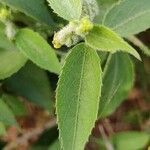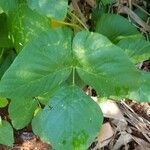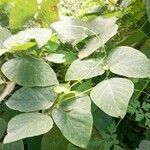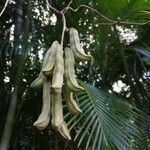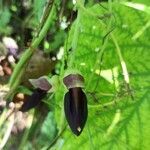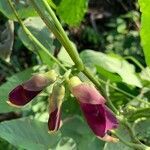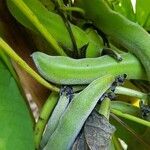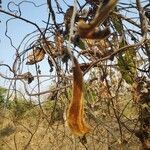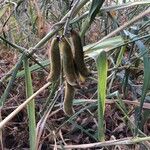Climbing herb 2–3 m. long, usually annual or a short-lived perennial, but also stated to climb to the tops of tall trees.. Stems densely hairy at first, later glabrous.. Leaflets rather thin, obovate, elliptic, rhomboid or ovate, the laterals very oblique, 4·8–19 cm. long, 3·4–16·8 cm. wide, acute or acuminate or rarely rounded at the apex, rounded at the base, sparsely to densely adpressed grey or silvery hairy on both surfaces, not blackening on drying; petiole 2–40 cm. long; rhachis 1–5 cm. long; petiolules 3–6 mm. long.. Inflorescences silvery pubescent; rhachis 2–29 cm. long; peduncle 2–18 cm. long; flowers 2–3 per node, on pedicels 1·5–6 mm. long; bracts 1–1·5 cm. long, 6 mm. wide; bracteoles very deciduous, 1 cm. long, 2 mm. wide.. Calyx adpressed silvery pubescent; tube 5–7 mm. long; lobes 3–9 mm. long, the lower linear-lanceolate to triangular, the upper pair joined to form a triangular lip.. Standard blackish-purple to pale lilac or white, ovate, 1·7–2·2 cm. long, 1·4–1·5 cm. wide; wings pale lilac to purple, 3–3·5 cm. long; keel white, tinged mauve, 3·2–3·7 cm. long, apical beak recurved and horny; staminal tube white.. Pods oblong, often S-shaped, 4–9 cm. long, 1–1·5 cm. wide (sometimes 2 cm. in cultivated forms), densely covered with brown or reddish-orange irritant bristly hairs which sometimes appear black in the mass, longitudinally ribbed under the hairs; in some cultivated forms the pods are glabrescent or velvety hairy but lack the bristles.. Seeds pinkish-brown speckled black or almost entirely black (or white to black in cultivars), oblong-ellipsoid, compressed, longest dimension 1–1·9 cm., shorter dimension 7·5–13 mm., thickness 4–6·5 mm.; hilum oblong, ± 4 mm. long; rim-aril cream, somewhat wrinkled and with a scale-like extension.
Climbing herb 1-4.5(6) m long, usually annual or a short-lived perennial but also stated to climb to the tops of tall trees. Stems densely hairy at first, later glabrous. Leaflets rather thin, 4.8-19 x 3.4-16.8 cm, obovate, elliptic, rhombic or ovate, the laterals very oblique, acute or acuminate or rarely rounded at the apex, rounded at the base, sparsely to densely appressed grey or silvery hairy on both surfaces, not blackening on drying; petiole 2-40 cm long; rhachis 1-5 cm long; petiolules 3-6 mm long. Inflorescences silvery pubescent; rhachis 2-29 cm long; peduncle 2-18 cm long; flowers 2-3 per node, on pedicels 1.5-6 mm long; bracts 10-15 x 6 mm; bracteoles 10 x 2 mm, very deciduous. Calyx appressed silvery pubescent; tube 5-7 mm long; lobes 3-9 mm long, the lower linear-lanceolate to triangular, the upper pair joined to form a triangular lip. Standard blackish-purple to pale lilac or white, 1.7-2.2 x 1.4-1.5 cm, ovate, investing wings and not becoming erect; wings pale lilac to purple, 3-3.5 cm long; keel white, tinged mauve, 3.2-3.7 cm long, apical beak recurved and horny; staminal tube white. Pods 4-9 x 1-1.5 cm (sometimes 2 cm in cultivated forms), oblong, often S-shaped, densely covered with brown or reddish-orange irritant bristly hairs which sometimes appear black in the mass, longitudinally ribbed under the hairs; in some cultivated forms the pods are glabrescent or velvety hairy but lack the bristles. Seeds pinkish-brown speckled black or almost entirely black (or white to black in cultivars), 10-19 x 7.5-13 x 4-6.5 mm, oblong-ellipsoid, compressed; hilum c. 4 mm long, oblong; rim aril cream, somewhat wrinkled and with a scale-like extension.
An evergreen herb of shrub. It is a climbing vine. It climbs to 6 m high. It can re-grow each year or live for a few years. The stems are slender with long, slender branches. They are very hairy when young. The leaves are alternate with sword shaped leaves. The leaf stalks are hairy. There are 3 leaflets. The leaflets are 5-19 cm long and 4-16 cm wide. The leaflets are rounded at the base and the side leaflets are unequal in shape. The flowers are large and white with bluish butterfly shaped petals. They occur in clusters of 2 or 3. The flowers are 2-4 cm long. The fruit are thick, leathery pods covered with hairs. They are 10 cm long and contain 4-6 seeds. The pods are dark brown.
Leaflets rather thin, 4.8–19 × 3.4–16.8 cm, obovate, elliptic, rhombic or ovate, the laterals very oblique, acute or acuminate or rarely rounded at the apex, rounded at the base, sparsely to densely appressed grey or silvery hairy on both surfaces, not blackening on drying; petiole 2–40 cm long; rhachis 1–5 cm long; petiolules 3–6 mm long.
Pods 4–9 × 1–1.5 cm (sometimes 2 cm in cultivated forms), oblong, often S-shaped, densely covered with brown or reddish-orange irritant bristly hairs which sometimes appear black in the mass, longitudinally ribbed under the hairs; in some cultivated forms the pods are glabrescent or velvety hairy but lack the bristles.
Standard blackish-purple to pale lilac or white, 1.7–2.2 × 1.4–1.5 cm, ovate, investing wings and not becoming erect; wings pale lilac to purple, 3–3.5 cm long; keel white, tinged mauve, 3.2–3.7 cm long, apical beak recurved and horny; staminal tube white.
Seeds pinkish-brown speckled black or almost entirely black (or white to black in cultivars), 10–19 × 7.5–13 × 4–6.5 mm, oblong-ellipsoid, compressed; hilum c. 4 mm long, oblong; rim aril cream, somewhat wrinkled and with a scale-like extension.
Inflorescences silvery pubescent; rhachis 2–29 cm long; peduncle 2–18 cm long; flowers 2–3 per node, on pedicels 1.5–6 mm long; bracts 10–15 × 6 mm; bracteoles 10 × 2 mm, very deciduous.
Calyx appressed silvery pubescent; tube 5–7 mm long; lobes 3–9 mm long, the lower linear-lanceolate to triangular, the upper pair joined to form a triangular lip.
Climbing herb 1–4.5(6) m long, usually annual or a short-lived perennial but also stated to climb to the tops of tall trees.
Stems densely hairy at first, later glabrous.
